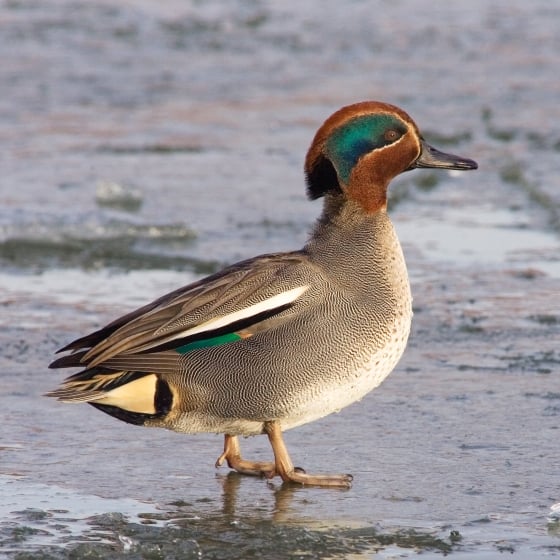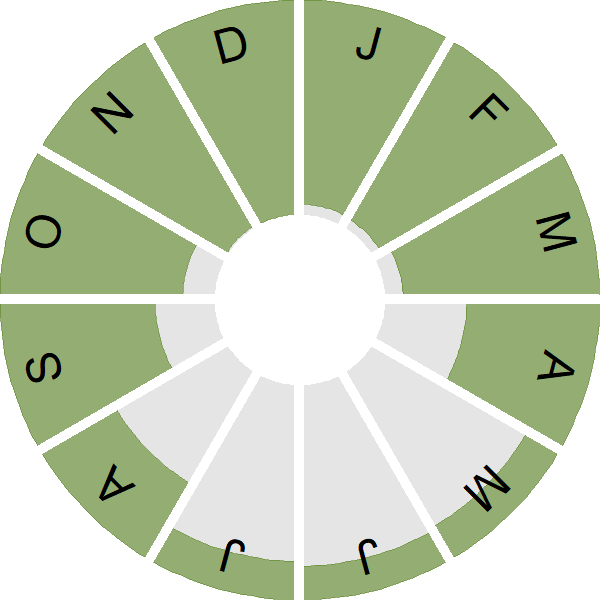Teal

Introduction
The Teal is our smallest duck and its bright green wing flash can be seen in marshlands across the UK.
This is an uncommon breeding bird in the UK, with an estimated population of just 4,000 pairs but this population is dwarfed by the winter arrival of around half a million birds from the Continent. At this time the male Teal is at his most resplendent, with a gilt-edged, chestnut and green head and a butter-yellow triangle beneath the tail. The scalloped, brown female shares the bright green wing flash of the male.
Wetland Bird Survey results show an upward trend for Teal across the UK and, unsurprisingly, that numbers peak between October and February. Since the 1968–72 breeding atlas, however, there has been a 14% decrease in the size of the breeding range in Britain.

Key Stats
Identification
ID Videos
This section features BTO training videos headlining this species, or featuring it as a potential confusion species.
Female dabbling ducks
Garganey & Teal
Songs and Calls
Call:
Alarm call:
Status and Trends
Conservation Status
Population Change
Although much more abundant as a winter visitor, the Teal has a small breeding population of 2,700 to 4,750 breeding pairs (APEP4), with breeding numbers having increased since the time of the 1988–91 Breeding Atlas. However, the status is complicated by the presence of wintering and migrant birds until the end of April, and there has been a 14% range decrease since the 1968–72 Breeding Atlas; hence the longer term trend is unknown.
Distribution
In winter Teal are widespread throughout Britain & Ireland, being found in a variety of coastal and freshwater sites from small pools to large estuaries. The breeding season distribution map is distorted by the continued presence of wintering birds through to the end of April. Breeding Teal are patchily distributed in southern Britain and in Ireland.
Occupied 10-km squares in UK
2007/08–10/11
or view it on Bird Atlas Mapstore.
2008–11
or view it on Bird Atlas Mapstore.
European Distribution Map
Distribution Change
Change in occupied 10-km squares in the UK
from 1981–84 to 2007–11
or view it on Bird Atlas Mapstore.
from 1968–72 to 2008–11
or view it on Bird Atlas Mapstore.
Seasonality
Teals are common winter visitors, recorded on up to 20% of lists but scarce in summer when there is a small over-summering population and small numbers breed.
Weekly pattern of occurrence
The graph shows when the species is present in the UK, with taller bars indicating a higher likelihood of encountering the species in appropriate regions and habitats.

Movement
Britain & Ireland movement
Foreign locations of birds ringed or recovered in Britain & Ireland
Dots show the foreign destinations of birds ringed in Britain & Ireland, and the origins of birds ringed overseas that were subsequently recaptured, resighted or found dead in Britain & Ireland. Dot colours indicate the time of year that the species was present at the location.
- Winter (Nov-Feb)
- Spring (Mar-Apr)
- Summer (May-Jul)
- Autumn (Aug-Oct)

European movements
EuroBirdPortal uses birdwatcher's records, such as those logged in BirdTrack to map the flows of birds as they arrive and depart Europe. See maps for this species here.
The Eurasian-African Migration Atlas shows movements of individual birds ringed or recovered in Europe. See maps for this species here.
Biology
Productivity and Nesting
Nesting timing
Egg measurements
Clutch Size
Survival and Longevity
Survival is shown as the proportion of birds surviving from one year to the next and is derived from bird ringing data. It can also be used to estimate how long birds typically live.
View number ringed each year in the Online Ringing Report.
Lifespan
Survival of adults
Biometrics
Wing length and body weights are from live birds (source).
Wing length
Body weight
Ring Size
Classification, names and codes
Classification and Codes
- Order: Anseriformes
- Family: Anatidae
- Scientific name: Anas crecca
- Authority: Linnaeus, 1758
- BTO 2-letter code: T.
- BTO 5-letter code: TEAL.
- Euring code number: 1840
Alternate species names
- Catalan: xarxet comú
- Czech: círka obecná
- Danish: Krikand
- Dutch: Wintertaling
- Estonian: piilpart
- Finnish: tavi
- French: Sarcelle d’hiver
- Gaelic: Lach-bheag
- German: Krickente
- Hungarian: csörgo réce
- Icelandic: Urtönd
- Irish: Praslacha
- Italian: Alzavola
- Latvian: kriklis
- Lithuanian: rudagalve krykle
- Norwegian: Krikkand
- Polish: cyraneczka (zwyczajna)
- Portuguese: marrequinha
- Slovak: kacica chrapka
- Slovenian: kreheljc
- Spanish: Cerceta común
- Swedish: kricka
- Welsh: Corhwyaden
Research
Causes of Change and Solutions
Causes of change
The trend for the breeding population is uncertain and hence the drivers of change are also unclear.
Publications (1)
High pathogenicity avian influenza: Targeted active surveillance of wild birds to enable early detection of emerging disease threats
Author: Wade, D., Ashton-Butt, A., Scott, G., Reid, S., Coward, V., Hansen, R.D.E., Banyard, A.C. & Ward, A.
Published: 2022
The disease Highly Pathogenic Avian Influenza (HPAI) has caused significant damage to both wild bird populations and the poultry industry. Detection of the disease has tended to rely on the sampling of dead birds following the reporting of mortality events, but could a different approach provide advance warning of potential outbreaks?
11.12.22
Papers

More Evidence
More evidence from Conservation Evidence.com
Partners
Citing BirdFacts
If you wish to cite particular content in this page (e.g. a specific value) it is best to use the original sources as linked in the page. For a more general citation of the whole page please use: BTO (20XX) BirdFacts Species: profiles of birds occurring in the United Kingdom. BTO, Thetford (www.bto.org/birdfacts, accessed on xx/xx/xxxx).

